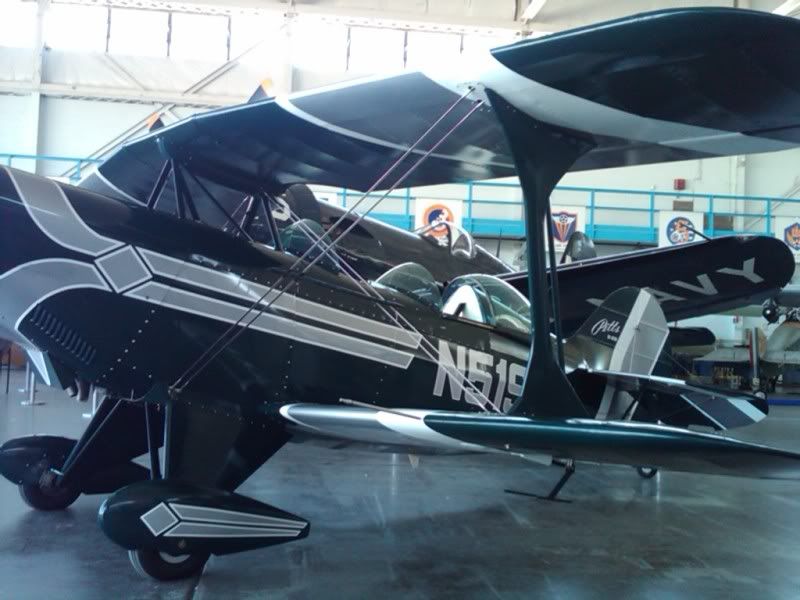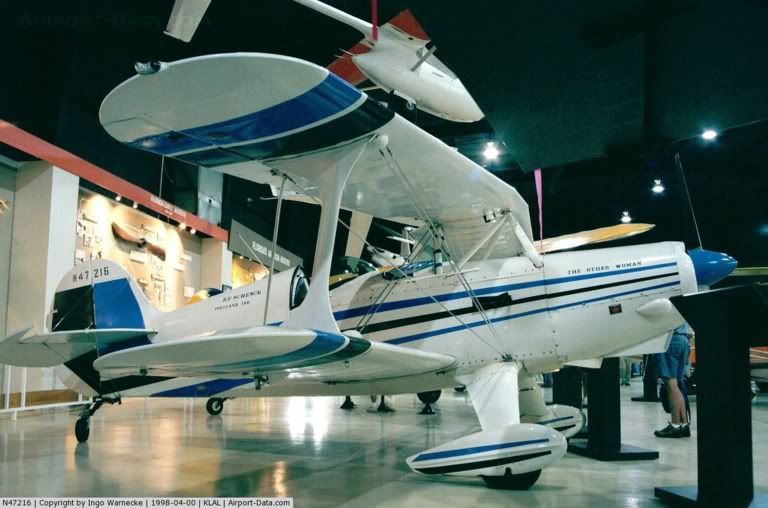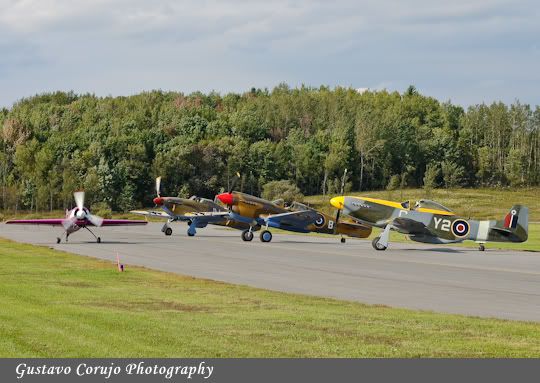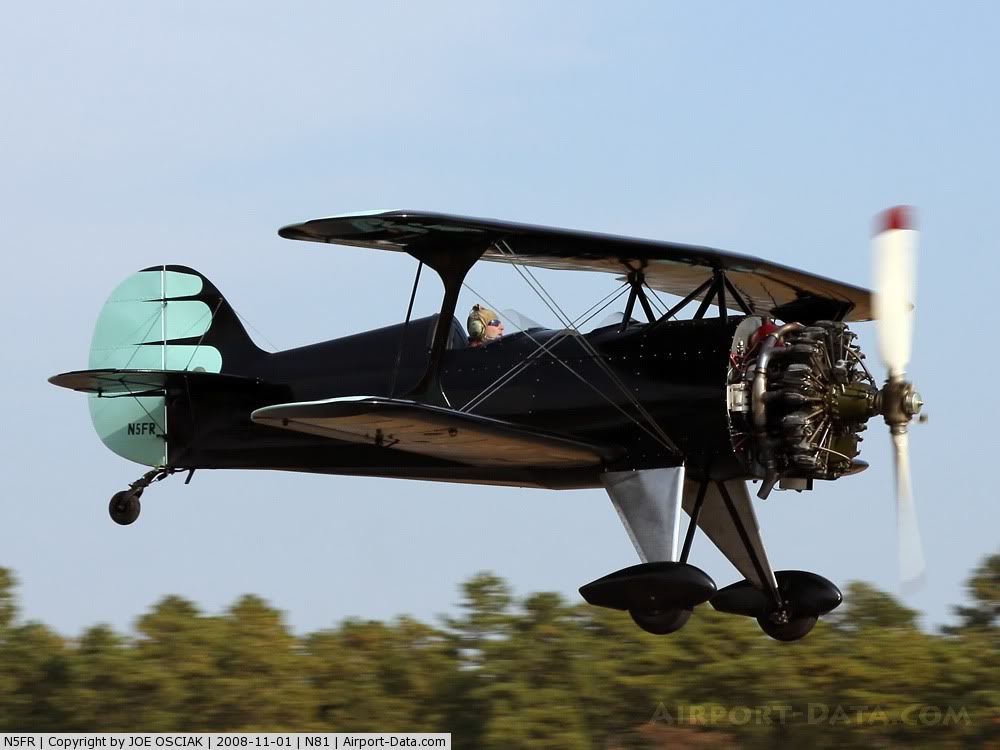Aerobatic mount to warbird/fighter transition
Fri Oct 01, 2010 10:32 pm
There's an interesting article in the Sept edition of the Sport Aerobatics (IAC publication) written by Rick Volker that speaks to comparisons between high performance acro aircraft and fighters. There's also a nice shot of his Sukhoi in formation with Bald Eagle (with Patti flying the 51). He talks about flying the SpitIX and a BF109E.
Here's to hoping he's right and my continued Pitts experience will help prepare me. If nothing else, I saved 1.9M and still have a ton of fun, and the view over the nose is similar!

Here's to hoping he's right and my continued Pitts experience will help prepare me. If nothing else, I saved 1.9M and still have a ton of fun, and the view over the nose is similar!

Re: Aerobatic mount to warbird/fighter transition
Sat Oct 02, 2010 12:55 am
Me likey yo Pitts!
I've got a Skybolt refurb project sitting in the hangar awaiting some attention. It only has the 180-horse but its complete and could theoretically be flown as is - almost (its got a half-finished bubble canopy mod). In all honesty its an oooold build so we're planning to go completely through it before it flies again. It spent a lot of time gathering dust on display at the air museum in Lakeland, Floridaduring the 80s-90s.
If it ends up looking half as slick as yours I'll be content. Priority number one - change the hideous paint scheme!
Priority number one - change the hideous paint scheme!

I've got a Skybolt refurb project sitting in the hangar awaiting some attention. It only has the 180-horse but its complete and could theoretically be flown as is - almost (its got a half-finished bubble canopy mod). In all honesty its an oooold build so we're planning to go completely through it before it flies again. It spent a lot of time gathering dust on display at the air museum in Lakeland, Floridaduring the 80s-90s.
If it ends up looking half as slick as yours I'll be content.

Re: Aerobatic mount to warbird/fighter transition
Sat Oct 02, 2010 6:50 am
that black pitts is a beauty! i remember the first time i saw one.(many years ago) i loved it. and was shocked how little they are!. didnt they make a radial powered skybolt also?
Re: Aerobatic mount to warbird/fighter transition
Sat Oct 02, 2010 10:26 am
I keep meeting Rick in all the best places.

He has a unique perspective, coming from a hard-a$$ aerobatic background, and currently flying the "Hat Trick" of Spitfire, Hurricane, and Me-109. Good for him!
Another Canadian pilot has also done that recently, Rob Erdos, of the National Research Council, and a pilot for Vintage Wings.
Looking forward to reading the article.
Dave

He has a unique perspective, coming from a hard-a$$ aerobatic background, and currently flying the "Hat Trick" of Spitfire, Hurricane, and Me-109. Good for him!
Another Canadian pilot has also done that recently, Rob Erdos, of the National Research Council, and a pilot for Vintage Wings.
Looking forward to reading the article.
Dave
Re: Aerobatic mount to warbird/fighter transition
Sat Oct 02, 2010 11:17 am
Both the Skybolt and the Pitts come in radial versions.
The Skybolt R

Pitts Model 12

The Skybolt R

Pitts Model 12

Re: Aerobatic mount to warbird/fighter transition
Sat Oct 02, 2010 11:52 am
Rob M- that Skybolt project will be alot of fun for you. I enjoyed refurbing the Pitts as much as I do flying it. Plus, I got intimately familiar with every last square inch of it too. Figure about a 1000 man hours to do all new fabric and paint. If I remember correctly, you had an RV project going. Is it flying yet?
RoB K - Thanks. The color is actually dark green with silver & white stripes, but the hangar was a bit dark, so the color does look black (it's aerothane forest green).
RoB K - Thanks. The color is actually dark green with silver & white stripes, but the hangar was a bit dark, so the color does look black (it's aerothane forest green).
Re: Aerobatic mount to warbird/fighter transition
Sat Oct 02, 2010 4:47 pm
How about a pilot going the other direction? I have some time in high performance fighters, though not a 109; but have very little exposure to top acro specialized planes. I got a short flight in a Chrisian Eagle, and didn';t like it that much. It was quick on the ailerons, but seemed sort of unstable to me. I've never been in a Sukoi, have been told that they are a bit strange to fly and take some getting used to, nor have I been in a Pitts. I have tried a couple of Vintage acro types, Buecker which is fabulous in the air, and several Chipmunks which I also like very much.
I do see some folks take some short cuts in acro planes, like abreviated patterns and such that are not the best habits to form in warbirds, and I wonder if these might lead to problenms. I know of two that were fatal, both to world and national first class acro pilots.
One thing about the acro stuff , if you make a mistake it is likely to be much less expensise than in a rare warbird type.
Ideally, I'd like to experience and be good in all types of planes.
I do see some folks take some short cuts in acro planes, like abreviated patterns and such that are not the best habits to form in warbirds, and I wonder if these might lead to problenms. I know of two that were fatal, both to world and national first class acro pilots.
One thing about the acro stuff , if you make a mistake it is likely to be much less expensise than in a rare warbird type.
Ideally, I'd like to experience and be good in all types of planes.
Re: Aerobatic mount to warbird/fighter transition
Sun Oct 03, 2010 12:10 am
I owned a very early S-1C Pitts for a few years, I did my transition to the type in a Christian Eagle. I was flying Citabrias and Decathalons regularly, and at the time I was flying in the AT-6. One of the issues with some of the Pitts Specials (and Eagles) is they can fly a bit differently depending on the skill of the builder. I flew two different Christian Eagles, both felt stable to me, at least as stable as a AT-6 or the Spitfire I flew in once. In the last year and a half I've flown in a Pitts S-2B and a P-40N. The S-2B is harder to see out of than either my S-1C or the Christian Eagle, but much more powerful. It also seems much squirrelier on landing and takeoff than the other biplanes. These planes are much lighter than any fighter or fighter trainer, they have less inertia and much simpler systems (if any). On the other hand, final on my S-1C was 90mph, 110mph on the S-2B, this about as fast as an AT-6 or Spitfire. They are all an awful lot of fun.
Re: Aerobatic mount to warbird/fighter transition
Sun Oct 03, 2010 12:11 pm
A good acro ship does not a fighter make, nor vice versa. Ask the Italians (Regia Aeronautica that is)
A fighter's job first and foremost is as a weapons carrier. It's a means to get a number of guns from point A to point B, shoot point B down then return, eventually back to point A. Possibly while keeping point B from shooting down points C, but anyway...
While the compromises put on a fighter to achieve high performance may make it a handful, to do it's job it also has to be a stable gun platform, and not wear out the pilot with bad behavior before or after. An aerobatic performer has no such restrictions. Imagine having to fly an eight hour escort mission with a Pitts, or Zivko
A fighter's job first and foremost is as a weapons carrier. It's a means to get a number of guns from point A to point B, shoot point B down then return, eventually back to point A. Possibly while keeping point B from shooting down points C, but anyway...
While the compromises put on a fighter to achieve high performance may make it a handful, to do it's job it also has to be a stable gun platform, and not wear out the pilot with bad behavior before or after. An aerobatic performer has no such restrictions. Imagine having to fly an eight hour escort mission with a Pitts, or Zivko
Re: Aerobatic mount to warbird/fighter transition
Mon Oct 04, 2010 1:11 pm
Mike , as for final approach speeds, that is one category that I value as making a plane a good, friendly, and useful, safer, all around plane,even with high perforance.
Obviously when you go for some all out extreme, like Rare Bear or Strega, you may have short wings or no flaps,and so can't fly verywell at slower speeds.
BUt some more general purpose planes seem to do more things well.
The suggested final approach speed of the Mk IX single seat Spitfire in Canada is 80 MPH which is plenty, This is full flaps, the only kind in Spits, and throttled fully back by the threshold. When going into its home field which is pretty short and has an obstacle to dodge on short final, I made sure to be 80 mph on short final and decelerating by the flare; defintiely not maintaining a touching down on the wheels at 80 mph. This worked out fine, light braking slowed me to turn off about 2/3 of the way down. This is not a landing area that you'd want to be sloppy coming into and be 10 mph fast and float half way down.I was concentrating very much from downwind on around.
Flying the Harvard into the same airport, I used 70 KNOTS on short final and it was not a problem, it slows down easily once on the ground. I make or try to make 3 point landings in both types. When I refer to these speeds, I mean on short final, that is about the last time I glance at the airspped indicator, just before the flare. I don't mean way out when turning base to final.
I don't know the final approach speed of the 109, but just in watching it seems no faster, mayhbe even slower, than a Spitfire.
For my two seat Spitfire, slightly heavier than a single seater, I use 80 KNOTS as the short final speed,and it seems good. That is 1.3 x VSO of 62 knots.
I have never flown in a Pitts, but just in watchinig them land, it seems they often are flown in pretty fast. That may have to do with the model Pitts or maybe the abilty and preference of the pilot.
Obviously when you go for some all out extreme, like Rare Bear or Strega, you may have short wings or no flaps,and so can't fly verywell at slower speeds.
BUt some more general purpose planes seem to do more things well.
The suggested final approach speed of the Mk IX single seat Spitfire in Canada is 80 MPH which is plenty, This is full flaps, the only kind in Spits, and throttled fully back by the threshold. When going into its home field which is pretty short and has an obstacle to dodge on short final, I made sure to be 80 mph on short final and decelerating by the flare; defintiely not maintaining a touching down on the wheels at 80 mph. This worked out fine, light braking slowed me to turn off about 2/3 of the way down. This is not a landing area that you'd want to be sloppy coming into and be 10 mph fast and float half way down.I was concentrating very much from downwind on around.
Flying the Harvard into the same airport, I used 70 KNOTS on short final and it was not a problem, it slows down easily once on the ground. I make or try to make 3 point landings in both types. When I refer to these speeds, I mean on short final, that is about the last time I glance at the airspped indicator, just before the flare. I don't mean way out when turning base to final.
I don't know the final approach speed of the 109, but just in watching it seems no faster, mayhbe even slower, than a Spitfire.
For my two seat Spitfire, slightly heavier than a single seater, I use 80 KNOTS as the short final speed,and it seems good. That is 1.3 x VSO of 62 knots.
I have never flown in a Pitts, but just in watchinig them land, it seems they often are flown in pretty fast. That may have to do with the model Pitts or maybe the abilty and preference of the pilot.
Re: Aerobatic mount to warbird/fighter transition
Mon Oct 04, 2010 2:49 pm
I flew an S-2B for about 5 years and also used 110 mph on approach, unless it was calm winds, and then I'd drop it down to 100 mph. The big thing about a Pitts, especially the 6 cylinder versions, is that they decelerate and drop very quickly when you pull the power, so carrying a bit extra speed with a touch of power is pretty harmless. I never flew curved approaches; instead I would turn final pretty high (i.e., didn't really descend on base), cut the power, and just "dump" it down short final, which I found always gave me "good enough" visibility. I also didn't like curved approaches as they block out 180 degres of your view, and more than once I've had someone pull out to take off while I was trucking down final. Things do happen fast, yes, but you quickly get used to it (by contrast, I would then fly our 182 and feel like I could have a cup of tea on final).
I've flown several types and serial numbers of Pitts, and found they all behaved differently on landing, which I think has a lot to do with how the gear was rigged (or how they were built, as noted above). I flew an S-1S once that was the most skittish plane on the ground imaginable; by contrast, I flew another that tracked straighter than a Cessna 150.
However, when I started to get some T-6 time, my first landings (and a few subsequent, "interesting" ones...) were characterized by wild swings on roll-out as I struggled to adjust to the sheer inertia of a T-6 as opposed to the Pitts. I also had to constantly keep myself from pulling too hard on vertical manuvers.
Personally, I found the S-2B to be one of the "most fun for the buck" airplanes I've flown (cross countries excluded!). The S-1 series are more manuverable, but I always found the rumble of an AEIO-540 up front in the S-2B to be intoxicating.
I've flown several types and serial numbers of Pitts, and found they all behaved differently on landing, which I think has a lot to do with how the gear was rigged (or how they were built, as noted above). I flew an S-1S once that was the most skittish plane on the ground imaginable; by contrast, I flew another that tracked straighter than a Cessna 150.
However, when I started to get some T-6 time, my first landings (and a few subsequent, "interesting" ones...) were characterized by wild swings on roll-out as I struggled to adjust to the sheer inertia of a T-6 as opposed to the Pitts. I also had to constantly keep myself from pulling too hard on vertical manuvers.
Personally, I found the S-2B to be one of the "most fun for the buck" airplanes I've flown (cross countries excluded!). The S-1 series are more manuverable, but I always found the rumble of an AEIO-540 up front in the S-2B to be intoxicating.
Re: Aerobatic mount to warbird/fighter transition
Mon Oct 04, 2010 4:15 pm
I have my original notes for my S-1C. My A/C was the 18th Pitts built. Very light, with flat bottom wings. Speeds were 120mph pattern, final 90mph to 100mph, touchdown at 80mph. The stall speed was 55mph, you could not possibly land with the angle of attack this represented. The A/C had a miss-adjusted throttle linkage when I bought it, it would not idle below about 1100rpm. This meant it didn't slow down on the ground much at all. Landings were a bear. With throttle adjusted correctly to idle about 500-600rpm, it was easy to land in all but dead calm conditions,in calm conditions it would wander a bit at about 50 mph until the tailwheel became effective at lower speeds.
The AT-6 I was flying was used for transition training for a P-51D that belonged to a club I was in. My notes for that AT-6 indicate we used 120mph pattern, 110mph base, 100mph initial final, and 75mph to 80 mph short final. We also spent a lot of time doing MCA and the practice stalls in T.O. No. 1F-51D-1 (Jan 1954) as part of the transition training.
I suspect the S-2B I flew in this year may have an issue with the landing gear. The twitches on takeoff and landing are predictable and harsh (I have not landed or taken off this A/C, just Akro). A landing I observed from the ground displayed a twitch to the right at the point I predicted from having flown in the A/C.
The AT-6 I was flying was used for transition training for a P-51D that belonged to a club I was in. My notes for that AT-6 indicate we used 120mph pattern, 110mph base, 100mph initial final, and 75mph to 80 mph short final. We also spent a lot of time doing MCA and the practice stalls in T.O. No. 1F-51D-1 (Jan 1954) as part of the transition training.
I suspect the S-2B I flew in this year may have an issue with the landing gear. The twitches on takeoff and landing are predictable and harsh (I have not landed or taken off this A/C, just Akro). A landing I observed from the ground displayed a twitch to the right at the point I predicted from having flown in the A/C.
Re: Aerobatic mount to warbird/fighter transition
Mon Oct 04, 2010 8:43 pm
Good discussion fellas.
There seems to be a very consistent message from those that have flown both- that the heavier (much heavier) WWII fighters require a different energy management since they do not trade kinetic and potential energy as easily as the lighter acro machines. I also read similar accounts that things happen faster (instantaneous) in Pitts, Extras, etc than they do in T-6, Mustang, etc. My guess is every model requires its own intrinsic criteria to "stay ahead of the airplane".
DB2 and Mike H gave good insight into the Pitts. Bill G - you need to fly one.
I've flown S2 A's and C's in addition to my B model (all factory built of course), but never been in the S1 series. All of them feel like planes that you become a part of vs. just sit in and manipulate. I like that characteristic. Things happen fast. Think it and it will do it. Throttle in and right foot in. Throttle out and left foot in. It's very neutral and doesn't have any self-compensating features, which to me is very pure. It will do exactly what you tell it to, until you tell it to do something else. How all of this translates to the bigger machines is something I hope I get the opportunity to discover someday.
There seems to be a very consistent message from those that have flown both- that the heavier (much heavier) WWII fighters require a different energy management since they do not trade kinetic and potential energy as easily as the lighter acro machines. I also read similar accounts that things happen faster (instantaneous) in Pitts, Extras, etc than they do in T-6, Mustang, etc. My guess is every model requires its own intrinsic criteria to "stay ahead of the airplane".
DB2 and Mike H gave good insight into the Pitts. Bill G - you need to fly one.
I've flown S2 A's and C's in addition to my B model (all factory built of course), but never been in the S1 series. All of them feel like planes that you become a part of vs. just sit in and manipulate. I like that characteristic. Things happen fast. Think it and it will do it. Throttle in and right foot in. Throttle out and left foot in. It's very neutral and doesn't have any self-compensating features, which to me is very pure. It will do exactly what you tell it to, until you tell it to do something else. How all of this translates to the bigger machines is something I hope I get the opportunity to discover someday.
Re: Aerobatic mount to warbird/fighter transition
Mon Oct 04, 2010 9:03 pm
My S-1C had much lighter controls than any of the 2 seat versions I flew. The flat bottom wing allowed it to loop at lower speeds and "G" loadings as well. It reminded me a lot of the L-2 Taylorcraft tandem spotter planes I did my tailwheel transition in. The L-2 had much more adverse yaw than the Pitts, and the L-2 was a good platform to learn "fancy footwork".